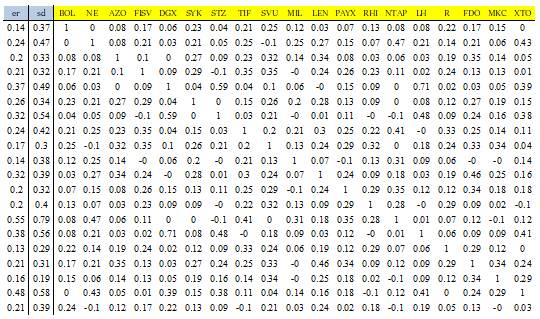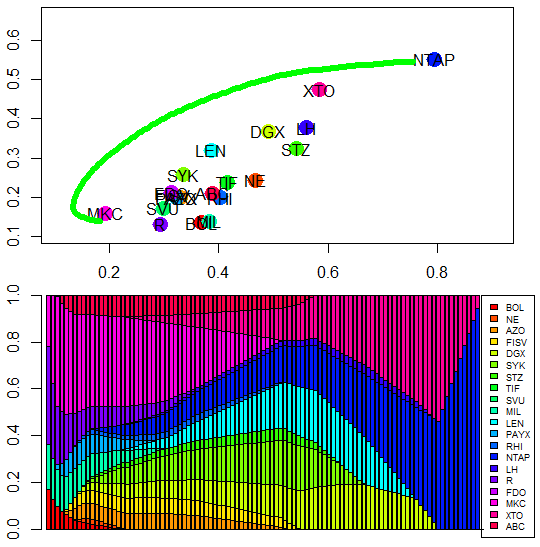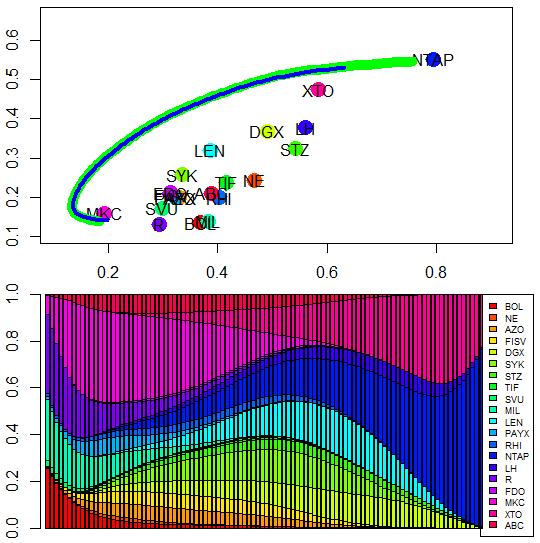Introduction
It is, however, cautious to apply MV model to practical problems because MV have some limitations such as error maximization or corner solution. This is regarded as serious problems since the diversification effect, which is the purpose of the portfolio optimization, is not achieved.
There are lots of alternative approaches to circumbent these problems. Michaud, inter alia, suggests the Resampled Efficiency (RE) portfolio model. This model is similar to Random Forest model but is not difficult to implement.
Michaud, Richard and Robert Michaud, 2007. “Estimation Error and Portfolio Optimization:A Resampling Solution”, New Frontier Advisors
Mean-Variance Portfolio Optimization Problem
Markowitz formulates mean-variance portfolio optimization problem as follows.
\[\begin{align} & min_{w} \frac{1}{2} w^{'}\Sigma w \\ & s.t. \\ & w^{'} [1,1,…,1]^{'} = 1 \\ & w ≥ 0 \\ & E(r)= w^{'} \mu \end{align}\]
Here, \(w\), \(\mu\), \(\Sigma\) denote weights vector, expected return vector, covariance matrix respectively. \(E(r)\) is a given target return.
The solution of the above problem is the optimal weight vector which minimizes the portfolio variance \((w^{'}\Sigma w )\) while attaining a given target expected return. This type of model is called as the quadratic programming and is solved using QP solver.
Resampled Portfolio Optimization Problem
Resampled portfolio (RE portfolio) uses the simulation sheme for generating th samples of expected return vector and covariance matrix as follows.
- Use the expected return and covariance matrix as input for multivariate normal distribution.
- From 1)'s multivariate normal distribution, simulate asset returns.
- From 2)'s simulated asset returns, calculate the mean and covariance matrix again.
- Using 3)'s mean and covariance matrix, run MV optimization.
- After iterating 1), 2), 3), 4) steps N times, calculate the average weight vector.
solveQPXT() function
Let's use R to perform MV and RE QP portfolio optimization. To solve a quadratic programming, we use the solveQPXT() function from the quadprogXT R package. The prototype of this function is as follows.
solveQPXT(Dmat,dvec,Amat,bvec,meq=0,factorized=FALSE)
Since the above specification of function is mapped to the following equations, we only need to know how to relate them.
\[\begin{align} & min_{w} \frac{1}{2} b^{'} D b - d^{'} b \\ & s.t. \\ & A^{'} b ≥ b_0 \end{align}\]
Data
For empirical analysis, we use Michaud (2007) paper's data which consists of the average, standard deviation, correlation of 20 asset classes.
R code for Portfolio optimization
R code for portfolio optimization 1) reads data, 2) perform MV portfolio optimization, and 3) RE portfolio optimization sequentially. Data can be downloaded at : mu_sd_corr_michaud.csv
#=========================================================================#
# Financial Econometrics & Derivatives, ML/DL using R, Python, Tensorflow
# by Sang-Heon Lee
#
# https://shleeai.blogspot.com
#-------------------------------------------------------------------------#
# Resampled Portfolio Optimization
#
# Reference
#
# Estimation Error and Portfolio Optimization:A Resampling Solution
# - Richard Michaud and Robert Michaud
#
# https://www.newfrontieradvisors.com/media/1138/estimation-error
# -and-portfolio-optimization-12-05.pdf
#=========================================================================#
graphics.off() # clear all graphs
rm(list = ls()) # remove all files from your workspace
library(quadprogXT) # solveQPXT
library(MASS) # mvrnorm
#-----------------------------------------------------
# Michuad dataset
#-----------------------------------------------------
setwd("D:/a_book_FIER_Ki_Lee/ch09_Portfolio/resampled")
# This dataset exists in appendix of Michaud and Michaud (2007)
df.data <- read.csv('mu_sd_corr_michaud.csv')
head(df.data)
# mean, std, correlation
mu <- as.vector(df.data[,1])
sd <- as.vector(df.data[,2])
corr <- as.matrix(df.data[,-c(1,2)])
# number of asset
nvar <- length(mu)
var.name <- colnames(df.data[,-c(1,2)])
# convert correlation to covariance matrix
cov <- diag(sd)%*%corr%*%diag(sd)
#-----------------------------------------------------
# Traditional portfolio optimization
#-----------------------------------------------------
n.er <- 100 # number of EF points
rset <- seq(min(mu),max(mu),length=n.er+2)
rset <- rset[2:n.er+1]
port1.ret <- rset
port1.std <- rset*0
port1.wgt <- matrix(0,n.er,nvar)
# calculate efficient frontier
for (i in 1:n.er) {
Dmat <- 2*cov
dvec <- rep(0,nvar) #c(0,0)
Amat <- t(rbind(t(rep(1,nvar)),t(mu),diag(nvar)))
bvec <- c(1,rset[i],rep(0,nvar))
# mean-variance optimization
m<-solveQPXT(Dmat,dvec,Amat,bvec,meq=2,factorized=FALSE)
# output
port1.std[i] <- sqrt(m$value)
port1.wgt[i,] <- t(m$solution)
}
# draw efficient fronter and allocation profile
x11(width=6); par(mfrow = c(2,1), mar = c(3,2,2,3), xpd=TRUE)
# individual asset
plot(sqrt(diag(cov)), mu,
xlim=c(0.8*min(port1.std),1.2*max(port1.std)),
ylim=c(0.8*min(mu),1.2*max(mu)),
col = rainbow(nvar), lwd = 10)
text(sqrt(diag(cov)), mu,
labels=var.name, cex= 1)
# efficient frontier
lines(port1.std,port1.ret,col = "green", lwd = 6)
# weight
barplot(t(port1.wgt),col=rainbow(nvar))
legend("topright", legend = var.name,
fill = rainbow(nvar), ncol = 1,
inset=c(-0.07,0), cex = 0.6)
#-----------------------------------------------------
# Resampled portfolio optimization
#-----------------------------------------------------
n.er <- 100 # number of EF points
rset <- seq(min(mu),max(mu),length=(n.er+2))
rset <- rset[2:(n.er+1)]
port.re.ret <- rset
port.re.std <- rset*0
port.re.wgt <- matrix(0,n.er,nvar)
n.rr = 1000 # number of resampling
for (rr in 1:n.rr) {
print(rr)
# simulated time series of assets
sim <- mvrnorm(n = 120, mu, cov)
# simulated mu & cov
mu.sim <- colMeans(sim)
cov.sim <- cov(sim)
rset.sim <- seq(min(mu.sim),max(mu.sim),length=(n.er+2))
rset.sim <- rset.sim[2:(n.er+1)]
port.sim.ret <- rset.sim
port.sim.std <- rset.sim*0
port.sim.wgt <- matrix(0,n.er,nvar)
# calculate efficient frontier
for (i in 1:n.er) {
Dmat <- 2*cov.sim
dvec <- rep(0,nvar)
Amat <- t(rbind(t(rep(1,nvar)),t(mu.sim),diag(nvar)))
bvec <- c(1,rset.sim[i],rep(0,nvar))
# mean-variance optimization
m<-solveQPXT(Dmat,dvec,Amat,bvec,meq=2,factorized=FALSE)
# output
port.sim.std[i] <- sqrt(m$value)
port.sim.wgt[i,] <- t(m$solution)
}
# sum of resampling portfolios before average
port.re.ret <- port.re.ret + port.sim.ret
port.re.wgt <- port.re.wgt + port.sim.wgt
}
# average of resampling portfolios
port.re.wgt <- port.re.wgt/n.rr
port.re.ret <- port.re.ret/n.rr
# portfolio SD and Expexted Return
for (i in 1:n.er) {
port.re.ret[i] <- port.re.wgt[i,]%*%mu
port.re.std[i] <- sqrt(port.re.wgt[i,]%*%cov%*%port.re.wgt[i,])
}
# draw efficient fronter and allocation profile
x11(width=6); par(mfrow = c(2,1), mar = c(3,2,2,3), xpd=TRUE)
# individual asset
plot(sqrt(diag(cov)), mu,
xlim=c(0.8*min(port1.std),1.2*max(port1.std)),
ylim=c(0.8*min(mu),1.2*max(mu)),
col = rainbow(nvar), lwd = 10)
text(sqrt(diag(cov)), mu,
labels=colnames(df.data[,3:22]), cex= 1)
# efficient frontier
lines(port1.std, port1.ret,col = "green" , lwd = 10)
lines(port.re.std, port.re.ret,col = "blue", lwd = 4)
# weight
barplot(t(port.re.wgt),col=rainbow(nvar))
legend("topright", legend = var.name,
fill = rainbow(nvar), ncol = 1,
inset=c(-0.07,0), cex = 0.6)
Running this R code draw the efficient frontier of MV portfolio and allocation weights profile as follows.
Efficient frontier is the standard deviation and expected return's locus of minimum variance portfolio with varying target expected returns. Rational investor selects the optimal portfolio on the efficient frontier according to his/her attitude of risk and return or risk appetite. As I mentioned earlier, we can find the abrupt changes of allocations which reduce the diversification effect.
However, we can find that allocation weights of RE portfolio generate the smoother changes than that of MV portoflio. This means weight chagnes of RE portoflio are not too sensitive unlike MV portfolio.
From these results, we learn MV and RE portoflio optimization model. Typcally, RE model is preferred to MV model because RE model delivers more diversified allocation and has the tendency to show the higher Sharpe ratio empirically or heuristically.
Next post will cover several important asset allocation models such as , Black-Litterman (BL) which incorporate market view into MV model, regime-switching portfolio optimization, dynamic portfolio optimization, and Machine / Deep Learning based portfolio optimization model, and so on. \(\blacksquare\)



on code
ReplyDeletefor (i in 1:n.er) {
Dmat <- 2*cov
dvec <- rep(0,nvar) #c(0,0)
Amat <- t(rbind(t(rep(1,nvar)),t(mu),diag(nvar)))
bvec <- c(1,rset[i],rep(0,nvar))
# mean-variance optimization
m<-solveQPXT(Dmat,dvec,Amat,bvec,meq=2,factorized=FALSE)
# output
port1.std[i] <- sqrt(m$value)
port1.wgt[i,] <- t(m$solution)
}
is giving error:
Error in (function (Dmat, dvec, Amat, Aind, bvec, meq = 0, factorized = FALSE) :
NA/NaN/Inf in foreign function call (arg 10)
on code
ReplyDeletefor (i in 1:n.er) {
Dmat <- 2*cov
dvec <- rep(0,nvar) #c(0,0)
Amat <- t(rbind(t(rep(1,nvar)),t(mu),diag(nvar)))
bvec <- c(1,rset[i],rep(0,nvar))
# mean-variance optimization
m<-solveQPXT(Dmat,dvec,Amat,bvec,meq=2,factorized=FALSE)
# output
port1.std[i] <- sqrt(m$value)
port1.wgt[i,] <- t(m$solution)
}
is giving error:
Error in (function (Dmat, dvec, Amat, Aind, bvec, meq = 0, factorized = FALSE) :
NA/NaN/Inf in foreign function call (arg 10)
for (i in 1:n.er) {
ReplyDeleteDmat <- 2*cov
dvec <- rep(0,nvar) #c(0,0)
Amat <- t(rbind(t(rep(1,nvar)),t(mu),diag(nvar)))
bvec <- c(1,rset[i],rep(0,nvar))
# mean-variance optimization
m<-solveQPXT(Dmat,dvec,Amat,bvec,meq=2,factorized=FALSE)
# output
port1.std[i] <- sqrt(m$value)
port1.wgt[i,] <- t(m$solution)
}
Error in (function (Dmat, dvec, Amat, Aind, bvec, meq = 0, factorized = FALSE) :
NA/NaN/Inf in foreign function call (arg 10)
what did I do wrong?
Thank you for your attention to this matter.
DeleteI added the link for data file in this post.
After that, I copied and pasted the above R code into R studio, and get the correct results.
In my environment, I can't see your problem.
For your information, the following are the versions of R and two packages in my computer.
R version 4.0.3 (2020-10-10)
quadprogXT version 0.0.5
MASS (built-in) version 7.3-53
Nice post, helped me out a lot. I'm also interested in the other asset allocation models, if you are still working on them :)
ReplyDeleteThank you.
DeleteI'm just glad I coluld be of some help.
I'll give it a try to upload another useful contents of asset allocation.
Thanks very much for the post, it is extremely helpful! I am trying to perform an optimization with the added constraints that one asset class has a fixed weight of 60% and all weights are non-negative. Please can you explain how I would do this. I would really appreciate it.
ReplyDeleteYou can add one more equality constraint : w1 = 0.6.
DeleteFor example, use the similar approach that the sum of weights is 1.
like w1+w2+w3 = 1 --> LHS = [ 1 1 1] , RHS=[1],
use w1 = 0.6 --> LHS = [1 0 0], RHS=[0.6]
Thank you, that makes a lot of sense! Can you please explain where exactly in the code I would add that constraint?
DeleteI think you had better study the manual of solveQPXT function step by step and will get all answers from that reference.
DeleteThanks for the help! Really appreciate your resources!
Delete